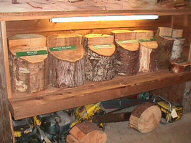 Volunteers;
all kinds of them, from everywhere. Kids, loggers, retired folks. Coming out and
working a few hours before or after work or when ever it was possible. The
building itself was built by the high school carpentry class. The delightful chain
saw carvings that adorn the outside of the building were donated by a local
carver. Everything in the museum was used at one time for what ever purpose it
was intended. After being discarded for itís obsoleteness, volunteers carted these
relics back to the museum. Each one with a story attached. As we arrived, the
buildings were getting a fresh coat of varnish, compliments of the local
correctional institute. Sherrill knew every item in the place and most of itís
history. The wife of a retired logger, she kept us attentive for a hour or more
with tales of the timber country in the good old days. At the visitors center next
door, two more volunteers cheerfully greeted us as we signed in. With all this,
there was still more.
Volunteers;
all kinds of them, from everywhere. Kids, loggers, retired folks. Coming out and
working a few hours before or after work or when ever it was possible. The
building itself was built by the high school carpentry class. The delightful chain
saw carvings that adorn the outside of the building were donated by a local
carver. Everything in the museum was used at one time for what ever purpose it
was intended. After being discarded for itís obsoleteness, volunteers carted these
relics back to the museum. Each one with a story attached. As we arrived, the
buildings were getting a fresh coat of varnish, compliments of the local
correctional institute. Sherrill knew every item in the place and most of itís
history. The wife of a retired logger, she kept us attentive for a hour or more
with tales of the timber country in the good old days. At the visitors center next
door, two more volunteers cheerfully greeted us as we signed in. With all this,
there was still more.
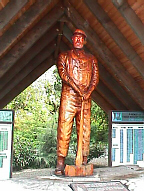 Three times a week, a volunteer borrows a station wagon
from the owner of one of the lumber mills and gives a tour of the forests and
mills that are available. There is no charge for this, although they wonít turn
down a donation for gas with is otherwise usually paid for by the driver. The
next tour would be tomorrow. At the end of the complex stands a small chapel
displaying a 12 foot statue of a logger carved out of a large tree. It is the work
of Dennis and Margaret Chastine, which they donated to form the basis of the
Loggers Memorial. The names of those who perished on the job are listed to
each side, grouped by years. The early logging years proved to be quite
hazardous for young loggers.
Three times a week, a volunteer borrows a station wagon
from the owner of one of the lumber mills and gives a tour of the forests and
mills that are available. There is no charge for this, although they wonít turn
down a donation for gas with is otherwise usually paid for by the driver. The
next tour would be tomorrow. At the end of the complex stands a small chapel
displaying a 12 foot statue of a logger carved out of a large tree. It is the work
of Dennis and Margaret Chastine, which they donated to form the basis of the
Loggers Memorial. The names of those who perished on the job are listed to
each side, grouped by years. The early logging years proved to be quite
hazardous for young loggers.
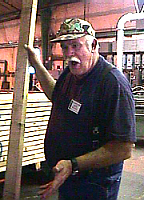 We returned the next day for the logging tour. Jack Zaccardo was a large framed
man who appeared quite suitable to the logging profession. A broad face and
gray mustache seemed to qualify him as the Paul Bunyan type. He was a retired
government logger, fireman and inspector, just to mention a few. He was a
wealth of knowledge, not to mention that he seemed to know everybody we ran
into. Our first trip was out into a clear cut area where stood the Worlds largest
western red cedar.
We returned the next day for the logging tour. Jack Zaccardo was a large framed
man who appeared quite suitable to the logging profession. A broad face and
gray mustache seemed to qualify him as the Paul Bunyan type. He was a retired
government logger, fireman and inspector, just to mention a few. He was a
wealth of knowledge, not to mention that he seemed to know everybody we ran
into. Our first trip was out into a clear cut area where stood the Worlds largest
western red cedar.
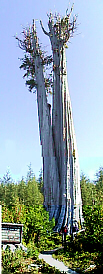 A behemoth standing 170 tall with a base diameter of almost
20 feet. Jack talked candidly about the logging business, past and present. Like
the salmon industry, logging is in constant conflict with itís competing elements
of loggers, government, and environmentalist. Many years ago, the Federal
Government gave to the State of Washington, millions of acres of old growth
forests to be used to fund the stateís needs. Today, contract logging on these
lands pays much of the public school debt. Very little of Washingtonís forest are
privately owned. Recently the Spotted Owl controversy raised by
environmentalists has resulted in a court injunction that has halted the harvesting
of some of these lands. On the days we were there, a high fire risk had shut
down all logging in the area.
A behemoth standing 170 tall with a base diameter of almost
20 feet. Jack talked candidly about the logging business, past and present. Like
the salmon industry, logging is in constant conflict with itís competing elements
of loggers, government, and environmentalist. Many years ago, the Federal
Government gave to the State of Washington, millions of acres of old growth
forests to be used to fund the stateís needs. Today, contract logging on these
lands pays much of the public school debt. Very little of Washingtonís forest are
privately owned. Recently the Spotted Owl controversy raised by
environmentalists has resulted in a court injunction that has halted the harvesting
of some of these lands. On the days we were there, a high fire risk had shut
down all logging in the area.
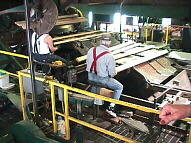 From the tree, we went to a lumber mill. The order
for the day was 2X4 construction beams. It is amazing the amount of large
machinery needed to reduce a large tree into 2X4s. One machine sliced the trunk
into a large square, taking off just enough to remove the bark. The bark was
wised away to the furnaces of the electric plant right there on the property.
Nothing goes to waist. The trimmed logs passed on down to the next machine
which cut them into yet smaller pieces and sent then further. Finally a rough
version of the 2X4 was produced and run over a conveyer where keen eyes
watched, dumping any rejects into a one way conveyance to the furnaces. Those
that pass inspection, and there are many such inspections along the way, finally
arrived at the planner where they were shaped into the finish product and pack on
pallets, ready for loading on the trucks. It was a highly automated process. The
human eye was everywhere watching, but very little was done as the boards
moved from machine to machine to pallet in a uninterrupted stream.
From the tree, we went to a lumber mill. The order
for the day was 2X4 construction beams. It is amazing the amount of large
machinery needed to reduce a large tree into 2X4s. One machine sliced the trunk
into a large square, taking off just enough to remove the bark. The bark was
wised away to the furnaces of the electric plant right there on the property.
Nothing goes to waist. The trimmed logs passed on down to the next machine
which cut them into yet smaller pieces and sent then further. Finally a rough
version of the 2X4 was produced and run over a conveyer where keen eyes
watched, dumping any rejects into a one way conveyance to the furnaces. Those
that pass inspection, and there are many such inspections along the way, finally
arrived at the planner where they were shaped into the finish product and pack on
pallets, ready for loading on the trucks. It was a highly automated process. The
human eye was everywhere watching, but very little was done as the boards
moved from machine to machine to pallet in a uninterrupted stream.
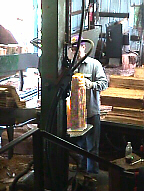 The next mill was just the opposite. A shake shingle mill which was pretty
much unchanged from itís pre-world war days. Red Cedar is all that is used,
prized for it splitting ability. It can be done in several ways. First split to about
an inch, it is then sawed diagonally so that one end is thin and the other fat. This
was fascinating, and some what frightening to watch, as there was literally no
safeguards or safety equipment in use. A conveyer belt moved the wood along to
each post which had a machine being operated by a person. The speed at which
they worked was unbelievable. At any second I expected to see a severed arm
go flying across the room. The wood moved at the speed of the belt and the
operators had to keep up with that speed. No breaks, no sit back and take a
breath. Arms flew in and around the machines like some high speed karate
demonstration. Wood seemed to fly everywhere, yet always ended up back on
the belt. I felt tired just watching. I didnít dare ask about medical plans
available. The tour ran about 3 hours and took in several more stops. Jack kept
up a constant flow of general and specific information about everything. Never
was a question asked, that he didnít have a knowledgeable answer. All in all it
was a great time.
The next mill was just the opposite. A shake shingle mill which was pretty
much unchanged from itís pre-world war days. Red Cedar is all that is used,
prized for it splitting ability. It can be done in several ways. First split to about
an inch, it is then sawed diagonally so that one end is thin and the other fat. This
was fascinating, and some what frightening to watch, as there was literally no
safeguards or safety equipment in use. A conveyer belt moved the wood along to
each post which had a machine being operated by a person. The speed at which
they worked was unbelievable. At any second I expected to see a severed arm
go flying across the room. The wood moved at the speed of the belt and the
operators had to keep up with that speed. No breaks, no sit back and take a
breath. Arms flew in and around the machines like some high speed karate
demonstration. Wood seemed to fly everywhere, yet always ended up back on
the belt. I felt tired just watching. I didnít dare ask about medical plans
available. The tour ran about 3 hours and took in several more stops. Jack kept
up a constant flow of general and specific information about everything. Never
was a question asked, that he didnít have a knowledgeable answer. All in all it
was a great time.
